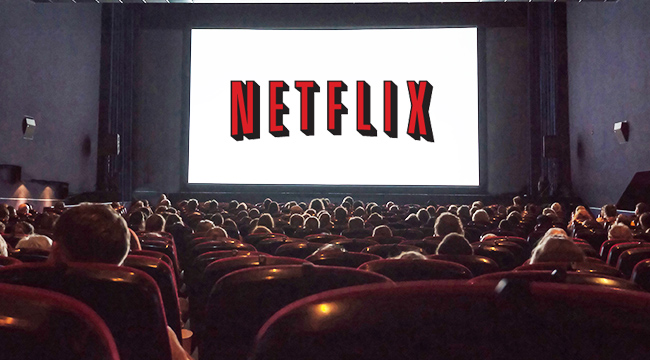
Bright has all the hallmarks of a massive Hollywood hit. Will Smith and David Ayer are fresh off Suicide Squad, a movie that grossed nearly three quarters of a billion dollars in theaters, and joined by Joel Edgerton and Noomi Rapace in a seemingly can’t-miss blockbuster about a human cop, played by Smith, and an orc, played by Joel Edgerton. It would probably do well in theaters, but it likely won’t play in a theater near you: The rights have been sold to Netflix, which only does a brief theatrical run for the movies it acquires before putting them up to stream.
Nor is it the only seemingly sure-fire theatrical hit that’s choosing Netflix over a traditional movie studio deal. Martin Scorsese’s mob movie The Irishman seems headed to the service (although impending legal action might mess up that deal). Adam Sandler has decided to leave theaters behind entirely and simply distribute his movies on Netflix, rapidly becoming one of the service’s top talents. Brad Pitt’s War Machine was arguably saved by Netflix in the first place, which stepped in with $60 million to produce the movie in 2015 when it was struggling. Sundance darling I Don’t Feel At Home In This World Anymore just arrived, to little fanfare, on Netflix despite winning the Grand Jury Prize, which generally assures the winner a theatrical run. What’s going on?
The problem, in part, is because Hollywood is struggling to make movies that aren’t either cheaper than $10 million or cost hundreds of millions. The issue, to some degree, is marketing. The basic mechanics of putting a movie in a theater, and putting eyeballs on screens to watch it, is costing more and more; in 2014, the average marketing cost of a Hollywood blockbuster was $100 million. Jordan Peele’s surprise hit Get Out, by contrast, cost $5 million to make.
For mid-range movies, that means the price tag goes from roughly, say, $50 million to make the movie to $150 million to get it into theaters. That’s a particular issue because many mid-range movies tend to be movies that don’t translate well to foreign audiences, i.e. you’re less likely to make your money back if it bombs in the U.S. For example, Bad Moms made $113 million here, five times its $20 million budget, but only $66 million overseas. By contrast, action flick xXx: The Return of Xander Cage cost four times as much and racked up just $44 million domestically, but collected $289 million overseas.
Not helping that squeeze is that after years of home video profits, which often ensured even the biggest box office bombs eventually broke even, home video is collapsing, thanks to, well, Netflix. That puts every movie in a situation where it has to be a hit out of the gate, or it will likely never make its money back.
For producers of mid-range movies, going to streaming services such as Netflix and Amazon is increasingly their only option. It may not have the prestige of a national theatrical release, although Netflix releases do get a qualifying Oscar run, and as the Amazon-produced Manchester By The Sea shows, you can still win prestigious awards. But you make your money back and you get to make your picture, and in Hollywood, few people ever get to claim either. But it also creates a perilous imbalance for studios, creatively and financially. Right now, Chinese investors, and the questionable box office numbers Chinese theaters put up, are supporting some of Hollywood’s riskier bets, but how long will that last? And creatively, it’s limited studio appetite for risk so much that they’d rather make a sequel nobody in America bothers with that Chinese audiences might like rather than roll the dice on something unproven.
On some level, this is just business as usual. If a Chinese company wants to essentially hire a Hollywood studio to make a movie that has little appeal outside of Chinese theaters, the only thing that matters is the studio’s check clears. But a hidden problem for Hollywood is that as it makes movies for the broadest possible global stage, the theaters at home might be have to start closing their doors.
A movie bombing domestically is an enormous problem for theater chains. Technically, when you go see a movie, you watch a print — or, more likely, its digital equivalent — of the movie the theater rented from the studio. The fee they pay is a percentage of the box office, which starts as high as 80% or 90% and steadily drops each weekend the movie plays in a theater. Theaters are constantly forced to raise ticket prices to cover Hollywood’s steep fees, which means attendance at theaters has been steadily falling for years, and may be approaching the point of no return
2016 was narrowly saved by a strong late summer and fall from being the single worst year for ticket sales in a century. Financially, IMAX and 3D screenings helped inflate ticket prices, but audiences have a limited taste for these. The real fiscal savior, lately, has been selling beer at the concession stand. But in order to sell beer and overpriced popcorn, theaters need audiences, and they’re not getting them.
There is, of course, cause for hope. Split and Get Out have both had tiny budgets and enormous grosses, showing that not every movie needs to have nine figures behind it. But it’s difficult not to look at Netflix and wonder how much of Hollywood’s future is being mortgaged. It’s a mistake to assume the only thing you get with your ticket in going to a movie is the movie itself. Filmgoing is powerful because it’s a shared experience, a way for a crowd of strangers to all feel a same powerful emotion at the same time. We may, however, be looking at a future where many movies never get that moment.






